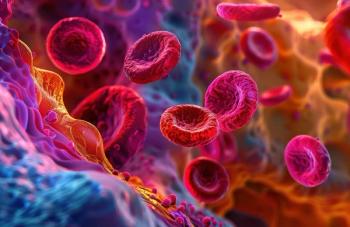
Retinal Vasculature Pathology Linked With MS Disease Burden
Distinct retinal vessel atrophy patterns may be associated with multiple sclerosis (MS), but further research is needed to assess retinal vessel changes and their underlying role in MS.
Patients with
Changes in the optic nerve and retina are often seen in patients with MS, which is a chronic neurodegenerative autoimmune condition causing inflammation, as well as demyelination and axonal loss in the central nervous system (CNS). Noninvasive imaging with optical coherence tomography (OCT) can be used to capture high-resolution visuals of the retina and detect inner retinal thinning, which is often found in patients with MS and is linked to neurodegenerative processes and possibly worse prognosis.
“Beyond retinal layer alterations, growing evidence suggests changes in the retinal vasculature in patients with MS,” the authors explained. “OCT angiography (OCTA), an extension of OCT imaging, allows for detailed visualization of the retinal vasculature. Here, successive scans are acquired at a single location of the retina. After removing stationary tissue signals, the residual signal represents moving erythrocytes in veins and arteries down to the capillary level.”
OCTA has been increasingly used to diagnose ophthalmologic conditions, and in neurodegenerative diseases, reduced vessel densities have been found to correlate with disease severity. In MS specifically, recent research suggests retinal vessel loss may be associated in MS disease activity.2
“It is controversially discussed whether superficial retinal vessel rarefication results from a primary retinal vessel pathology or results secondary to an altered retinal metabolism following ganglion cell loss,” the authors of the current study wrote.1
In a cross-sectional cohort study, the researchers investigated retinal vasculature changes among patients with MS with and without a history of optic neuritis (ON) by assessing OCTA images using a deep learning–based segmentation algorithm. The authors also correlated retinal vessel alterations to retinal architecture changes and visual functioning, with an aim of advancing hypotheses of the underlying pathology of vessel alterations. They analyzed vessel densities of the superficial (SVC) and deep (DVC) vascular complex.
A total of 259 patients with relapsing-remitting MS were included in the study, as well as 78 healthy controls. Patients’ eyes were stratified based on whether they had a history of ON (MS-ON) or no history of ON (MS-NON), with subclinical ON treated as clinical ON. A total of 107 eyes were excluded due to poor OCTA imaging, leaving 567 eyes from 337 participants for analysis.
The images showed rarefaction of SVC vessel densities among patients with MS regardless of ON status compared with healthy controls, while vessel measures of the DVC and foveal avascular zone were comparable across the study cohorts. Upon further analysis, there was a comparable loss of small vessels with a diameter lower then 10 μm in MS-ON and MS-NON eyes compared with healthy controls. Rarefaction of vessels with intermediate diameters (10-20 μm) and large diameters greater than 20 μm only occurred in MS-ON eyes compared with healthy controls.
In an analysis to determine whether SVC changes are associated with retinal architecture changes, the researchers found that loss of vessels with small and intermediate diameters was associated with thinning of the retinal nerve fiber layer regardless of ON history. Rarefaction of medium-size vessels was correlated with ganglion cell atrophy.
Regarding disease burden, small retinal vessel thinning was associated with increased disability, although the thinning of medium-size vessels was not. Thinning of both small- and medium-size vessels was associated with longer duration of disease.
“On one hand, we recognized a reduction of small-sized vessels (diameter < 10 μm) as a consistent finding in all MS eyes irrespective of an ON history. This change correlated with the MS disease burden and seemed to occur independently of retinal ganglion cell loss. On the other hand, rarefication of medium-sized vessels (diameter 10-20 μm) was predominantly detected in eyes with an ON history and was closely associated with ganglion cell loss. These findings suggest different pathophysiological mechanisms of retinal vessel pathology during MS,” the authors wrote.
Study limitations include OCTA being a relatively new technique, although experienced technicians carried out the measurements used in the study. OCTA also cannot differentiate between vessel constriction and genuine loss of vessels, the authors noted. The participants were also not assessed to confirm the absence of any subclinical eye disease or condition other than ON.
“In conclusion, a distinct atrophy pattern of superficial small- and medium-sized retinal vessels can be observed during MS,” the authors wrote. “Additional research is required to incorporate retinal vessel abnormalities into the pathophysiological framework of MS.”
References
1. Wicklein R, Kreitner L, Wild A, et al. Retinal small vessel pathology is associated with disease burden in multiple sclerosis. Mult Scler. 2024;30(7):812-819. doi:10.1177/13524585241247775
2. Noll C, Hiltensperger M, Aly L, et al. Association of the retinal vasculature, intrathecal immunity, and disability in multiple sclerosis. Front Immunol.2022;13:997043. doi:10.3389/fimmu.2022.997043
Newsletter
Stay ahead of policy, cost, and value—subscribe to AJMC for expert insights at the intersection of clinical care and health economics.












































